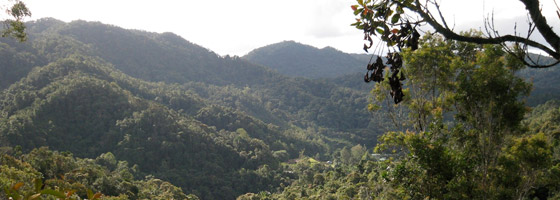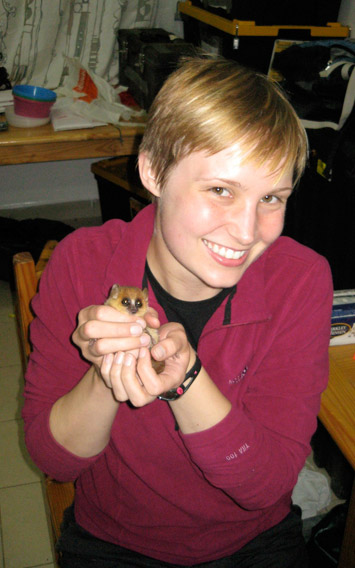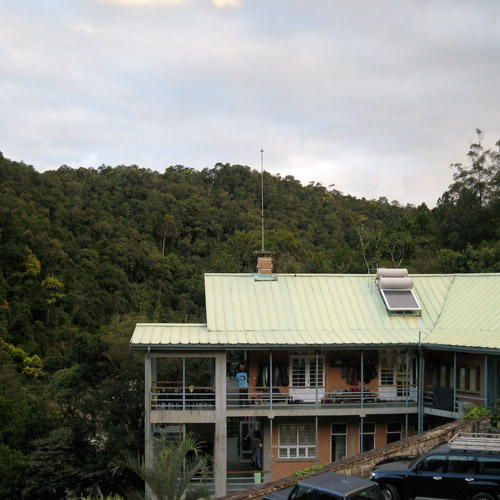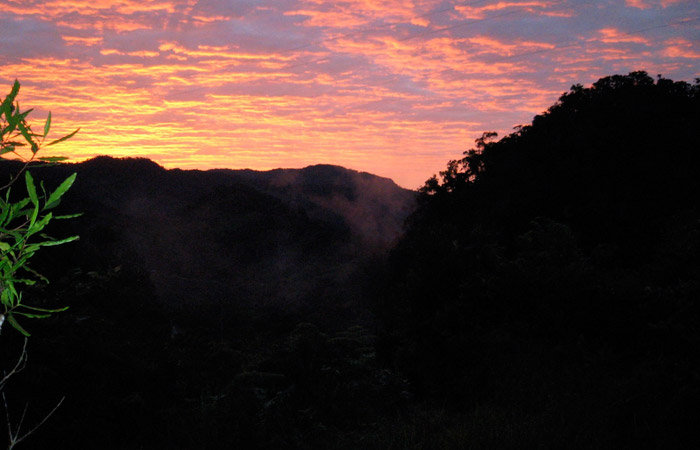Researcher tracks hibernation patterns of tiny primates

In recent years, the lush island country of Madagascar has been pounded by political turmoil and rain forest destruction. Despite all the disturbance, a small, wide-eyed primate manages to sleep through it all. The mouse lemur (Microcebus rufus), native to Madagascar’s rain forests, is a member of the only family of primates known to be nocturnal and hibernate during the dry season, when resources are scarce.  Stony Brook University graduate student Caitlin Karanewsky has been studying the mouse lemur’s hibernating patterns for four years, tracking the ways environmental cues affect this deep sleep period.
Stony Brook University graduate student Caitlin Karanewsky has been studying the mouse lemur’s hibernating patterns for four years, tracking the ways environmental cues affect this deep sleep period.
During yearly periods of resource abundance, the lemurs stuff themselves to gain a layer of fat that will keep their bodies satiated as they hibernate through the dry season. Unlike many animals, they thrive in areas of the rain forest that have been disturbed. Many of their favorite foods, such as mistletoe and guava, grow in disturbed areas. Insects are also more abundant in these areas, another lemur delicacy. However, lemurs may not be able to remain in hibernation because the decreased canopy cover causes the area to be warmer than ideal sleeping conditions require.
To study the effects of disturbed areas on mouse lemur hibernation, Karanewsky recorded ambient temperature in areas of different light exposure near her live traps. She used NexSens micro-T temperature loggers with iButton technology at each site.  The half-inch diameter loggers were easy to place among the trees and Karanewsky received temperature readings once every two hours. Because each logger has a unique identification, she could tell what temperatures were coming from each specific location. Karanewsky also tested the professed durability of the micro-T loggers. In addition to the abundance of wildlife, Madagascar’s rainy weather can be harsh on technology. During last year’s field season, Karanewsky had to leave abruptly after an injury, leaving the temperature loggers unattended in the field for two months. When her advisor brought them back, they were all still functional and held every data reading.
The half-inch diameter loggers were easy to place among the trees and Karanewsky received temperature readings once every two hours. Because each logger has a unique identification, she could tell what temperatures were coming from each specific location. Karanewsky also tested the professed durability of the micro-T loggers. In addition to the abundance of wildlife, Madagascar’s rainy weather can be harsh on technology. During last year’s field season, Karanewsky had to leave abruptly after an injury, leaving the temperature loggers unattended in the field for two months. When her advisor brought them back, they were all still functional and held every data reading.
“All of this lovely, unharmed data has allowed me to see exactly how different the disturbed and pristine forest is, temperature-wise,” Karanewsky said.
 Her research found that daytime temperatures in disturbed forest areas can be up to 10 degrees warmer than in untouched areas. Since the mouse lemurs need to stay cool for their metabolism to remain low, increased habitat destruction could put these small primates in danger. They are currently a species of “least concern” according to the International Union for Conservation of Nature.
Her research found that daytime temperatures in disturbed forest areas can be up to 10 degrees warmer than in untouched areas. Since the mouse lemurs need to stay cool for their metabolism to remain low, increased habitat destruction could put these small primates in danger. They are currently a species of “least concern” according to the International Union for Conservation of Nature.
“Changing climate and declining habitat quality could harm these seemingly hardy animals,” Karanewsky said.
Karanewsky is also collaborating with the Zurich Zoo in Switzerland, comparing the behavior of wild mouse lemurs in Madagascar to the captive mouse lemurs there.
Image credits: Caitlin Karanewsky, Martin Bauert, Zurich Zoo (lemur close-up, homepage)





0 comments